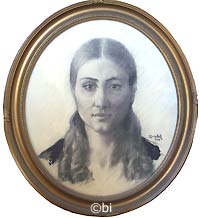|
 Rosetta Zingale Rosetta Zingale
Rosetta Zingale, painter, was born in Bronte
in 1916,
dead in Milan in 1996. She studied with the professor Carpi to The Brera Academy (Milan) where has
lived and worked actively, taking part in the national artistic life from
1956.
Milanese of adoption, her Sicilian nature was always expressed in her works.
Her pictorial mode remained decidedly Mediterranean with the impressive
lonely trees, the massive and impenetrable fortresses, the country towns
clinging to Etna's lava slopes or hidden in gorges of a
rocky spur, the flowers, the nature with her solar colors.
Her works are present in the major Italian collections and in many foreign
cities (New York, Buenos Aires, Paris, London, Brussels, Helsinki).
Our Rosetta had several "personal exhibitions" in Italy and abroad
besides the participations to the Prix Signature (Paris, 1969), Salon de
l'Art libre (Paris, 1961) and to very many Italian and foreign art shows
where it was appreciated and rewarded.
Because of her fecund work was called to be part, as merit
academician, of the Academy of the "500". On her art wrote, among the others, Leonardo Borgese, Dino Buzzati, Gino
Traversi and Dino Villani.
In 1962 Carlo
Carrà, was praising her as "deserving to be
signaled for the tonal seriousness and the composing value".
Rosetta Zingale died eighty years old in Milan in 1996;
after his death he wanted to leave to his hometown, donating
them to the Real Capizzi College,
many of his works, a large sum of money to create a scholarship
dedicated to the uncle sac. Anselmo Di Bella (Bronte 25.2.1882 -
Milan 2.3.1973, rector of the same College from 1936 to '41) in
favor of the deserving students of R. C. Capizzi and also his
personal objects (including an antique chandelier of his house).
It is buried in the family chapel of the Bronte cemetery.
Many works donated by the painter to her hometown were to be
part of the "Pinacoteca Nunzio Sciavarrello".
It is the appropriate location for a brontese artist of national
scope and it was natural and right to recognize her as a place
in the Sicilian art scene of the 900 and then dedicate a small
space to her.
Bronte's Pinacoteca is in fact presented as "a precious
testimony of the Sicilian and national artistic panorama between
the second and ninth decade of the 20th century" or
"documentation of artistic activity in Sicily and in particular
in the Etna area in the period from the 30s to the years '60."
Strangely, however, among the works of the many painters and
sculptors of the Sicilian artistic scene, one can not see a
painting by a Brontese painter named Rosetta Zingale. The
Zingale is unknown to the curators of the Art Gallery, for them
it is not part of the "Sicilian artistic panorama" and has no
place in the picture gallery of his hometown.
No one can admire his paintings left relegated and "secreted" in
the inaccessible rooms of what was once the direction of the
College. And you can not understand why.
A little more attention or gratitude in this case would not
hurt. It's really true, nemo propheta at home!
"The chromatic mix gains for the Zingale a
determinant importance, not only from the tonal values, also essential, but
even for the weight, for the consistency
of the superimposition from which derives that specific value that the artist can
confer a determinant plastic function".
(Mario
Monteverdi).
|